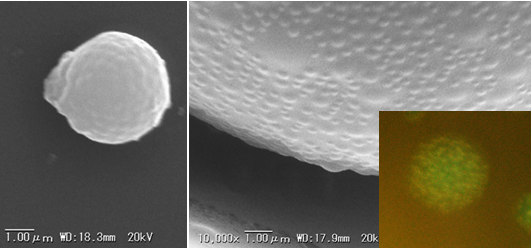千歳科学技術大学
2013年度 成果事例
Preparation of Phase-Separated Polymer Microparticles
(課題番号:S-13-CT-0011)
【研究目的】
Small phase-separated polymer particles play an important role in many fields of science, ranging from applications in electronics (e.g. electronic paper) to the medical field (e.g. biomarkers, drug delivery). There are several methods to prepare those nan0-and microparticles, and I chose the rapid solvent evaporation method. This method is versatile, quick and has been shown to produce a wide variety of polymer particle morphologies, in the case of a PMMA/polystyrene mixture(PS) [1]. I chose polysulfone (PSF), because it is a well-known engineering plastic with interesting properties.
【成 果】
Polysulfone and polystyrene was dissolved in chloroform and ethyl acetate, respectively at various concentrations and the solutions were mixed in various ratios. After sonication, the emulsion was cast on a glass slide and allowed to dry. This simple procedure produces mixed polymer particles. The particle size can be controlled by polymer concentration, and the particle morphology by mixing ratio and the presence of an emulsifier in the aqueous phase.
PMMA/PS mixtures lead to microparticles with a Janus-type morphology, that means large phase separated areas with the extreme of two hemispheres. The PSF/PS mixtures, on the other hand, lead to particles with a very fine surface morphology, as can be seen in Figure 1.

Figure 1: scheme of preparation method (left); SEM image of a polystyrene/polysulfone microparticle (center); SEM image of a PMMA/polysulfone microparticle. The inset is a fluorescence micrograph of a TNCQ-doped particle.
【参考論文】
- Y. Kiyono, L. Szikszai, J. Watanabe, O. Karthaus, R. Hass, M. Maiwald, O. Reich, H.-G. Löhmannsröben, e-J. Surf. Sci. Nanotech., 10, 360-366 (2012)






